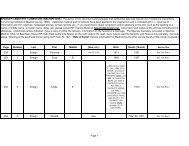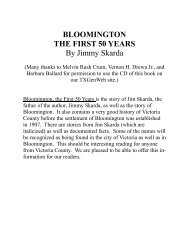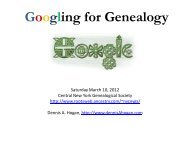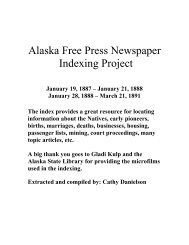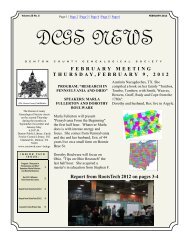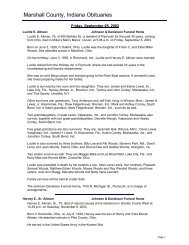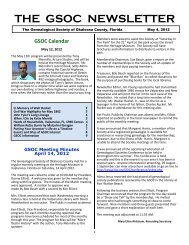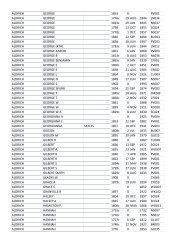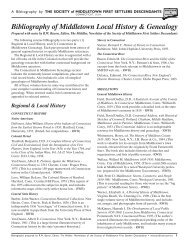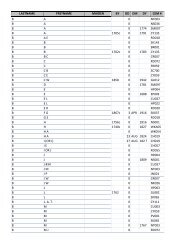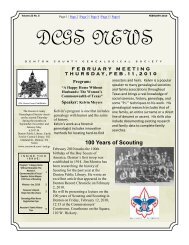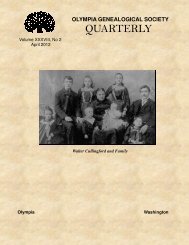Getting to the Roots of Your Family - RootsWeb - Ancestry.com
Getting to the Roots of Your Family - RootsWeb - Ancestry.com
Getting to the Roots of Your Family - RootsWeb - Ancestry.com
Create successful ePaper yourself
Turn your PDF publications into a flip-book with our unique Google optimized e-Paper software.
Canada, and Brazil began in <strong>the</strong> 1880s, with increased waves before, during, and after <strong>the</strong> two world<br />
wars. Almost all <strong>the</strong> remaining ethnic Germans were re-settled in <strong>the</strong> German Empire or Germanoccupied<br />
areas during World War II, but many had <strong>to</strong> flee from <strong>the</strong> advancing Russian armies at <strong>the</strong><br />
end <strong>of</strong> <strong>the</strong> war. Today most <strong>of</strong> Bukovina is part <strong>of</strong> Romania. The nor<strong>the</strong>rn part is in <strong>the</strong> Ukraine.<br />
Helpful Web sites<br />
• http://www.bukovinasociety.org/ - The Bukovina Society <strong>of</strong> <strong>the</strong> Americas, includes various<br />
his<strong>to</strong>rical articles and family his<strong>to</strong>ry material in English and German. A genealogy data base is<br />
available <strong>to</strong> members only<br />
• http://www.genealogienetz.de/reg/ESE/bukowina.html - Bukovina page <strong>of</strong> www.genealogy.net –<br />
includes links <strong>to</strong> maps, gazetteers, archive addresses, and o<strong>the</strong>r reference material.<br />
• http://www.deutsche-schutzgebiete.de/kuk_bukowina.htm - his<strong>to</strong>ry, statistics, links <strong>to</strong> o<strong>the</strong>r Web<br />
sites, his<strong>to</strong>rical postcards<br />
Germans in <strong>the</strong> former Kingdom <strong>of</strong> Hungary<br />
Germans settled in several distinct sections <strong>of</strong> Hungary: <strong>the</strong> so-called Swabian Turkey area<br />
[Schwäbische Türkei (Komitate Baranya, Tolna und Somogy)], Budapest and Central Hungary,<br />
Western Hungary [Komitate Gyõr,Moson, and Sopron], <strong>the</strong> area between <strong>the</strong> Danube and Theiss rivers<br />
[Batschka and Banat], and various villages clustered here and <strong>the</strong>re. By 1940 about 600,000 ethnic<br />
Germans lived in Hungary. Some areas are now located in Romania.<br />
Between 1711 and 1787, following <strong>the</strong> Habsburg monarchy’s conquest over <strong>the</strong> Ot<strong>to</strong>man Turks, <strong>the</strong><br />
Austrian government recruited predominantly German-speaking settlers from Germany and o<strong>the</strong>r<br />
European countries <strong>to</strong> populate <strong>the</strong> newly-won terri<strong>to</strong>ries. Many <strong>of</strong> <strong>the</strong> early settlers came from <strong>the</strong><br />
Southwestern region <strong>of</strong> Schwaben. They embarked on barges at Ulm, located in that region, and<br />
traveled down <strong>the</strong> Danube River <strong>to</strong> Hungary. Hence <strong>the</strong>y were later known as “Donauschwaben”, or<br />
“Danube-Swabians.<br />
The two largest settlement areas were known as <strong>the</strong> Banat and <strong>the</strong> Batschka, which became part <strong>of</strong><br />
Hungary, Romania, and Yugoslavia after World War II. O<strong>the</strong>r areas include <strong>the</strong> Sathmar region and <strong>the</strong><br />
Dobrudja,<br />
Collectively, <strong>the</strong>se groups are <strong>of</strong>ten referred <strong>to</strong> as Donauschwaben.<br />
Helpful Web sites:<br />
• http://www.dvhh.org/ - Donauschwaben Villages helping hands – very informative!<br />
• http://www.genealogienetz.de/reg/ESE/dschwaben.html - provides his<strong>to</strong>ry, lists <strong>of</strong> societies,<br />
genealogical resources etc.<br />
• http://www.genealogienetz.de/reg/ESE/dsinfo.htm - Donauschwaben village list, currently<br />
includes Banat, Batschka, Bosnia, Sathmar, and Slavonia, with more <strong>to</strong> <strong>com</strong>e.<br />
• http://www.genealogienetz.de/vereine/AKdFF/akdff-en.html - Work Group <strong>of</strong> Danube-Swabian<br />
Research [<strong>the</strong> major genealogical society for this area], has various geographical sub-groups<br />
• http://www.genealogienetz.de/reg/ESE/dssum.html - his<strong>to</strong>ry, genealogy resources, societies –<br />
focus on <strong>the</strong> Hungarian Highlands<br />
• http://www.genealogienetz.de/vereine/AGoFF/index.htm - Contact has extensive records and<br />
publications.



